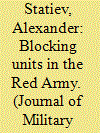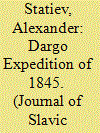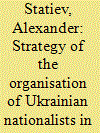|
|
|
Sort Order |
|
|
|
Items / Page
|
|
|
|
|
|
|
| Srl | Item |
| 1 |
ID:
116782


|
|
|
|
|
| Publication |
2012.
|
| Summary/Abstract |
After the German offensive toward Stalingrad began in 1942, Joseph Stalin issued Order No. 227 (the "Not a Step Back!" order), institutionalizing the blocking units that already existed in some divisions. This article examines the units and their place among the Red Army's other draconian policies. Historians interpret Order No. 227 as exceptionally harsh, yet the policies stemming from it were exceptional primarily in their methodical application rather than in their essence. A logical outcome of "the end justifies the means" Stalinist philosophy, blocking units made the army steadier and contributed to its victory. This was the only fact that mattered to the Soviet leaders, and they ignored the moral issues raised by the existence of the units.
|
|
|
|
|
|
|
|
|
|
|
|
|
|
|
|
| 2 |
ID:
167783


|
|
|
|
|
| Summary/Abstract |
This article examines the Dargo expedition, an episode of the Caucasus War waged in 1817–1864 by Russia against the tribes of the North Caucasus. In 1845, Tsar Nicholas I ordered a raid in the depth of the mountains controlled by rebels led by imam Shamil. The expedition, targeting the village of Dargo, Shamil’s residence, was to lure the tribesmen into a decisive battle, which the Russians were expected to win and thus destroy the protracted insurgency. However, the expedition ended in a spectacular failure, because its planners ignored the challenges of mountain warfare. The article focuses on these challenges and shows how the rebels’ skill in mountain warfare triumphed over the great superiority in numbers, firepower, and discipline enjoyed by the Russians.
|
|
|
|
|
|
|
|
|
|
|
|
|
|
|
|
| 3 |
ID:
170488


|
|
|
|
|
| Summary/Abstract |
In the late autumn of 1877 it seemed that the Russo-Turkish War had entered a stalemate: The Russian Army still stayed to the north of the Balkan Ridge, which was deemed to be impassable until spring. However, bold initiative backed by a series of thoughtful improvisations allowed the Russians to outmaneuver the Ottomans and cross the ridge. The numerous non-combat injuries sustained during this march were a fair price for the strategic surprise that paved the way to a total victory. In this case, the improvised approach to mountain warfare paid off, but the attempts to bet on improvisations in subsequent campaigns on a less forgiving mountainous terrain or against an enemy experienced in mountain warfare were to fail.
|
|
|
|
|
|
|
|
|
|
|
|
|
|
|
|
| 4 |
ID:
134598


|
|
|
|
|
| Summary/Abstract |
Applying the ‘victory at all costs’ principle adopted during World War II, partisans—the long arm of the Soviet regime in the occupied territories—pressured civilians to resist the enemy. The thinking behind most of their coercive policies seemed rational within the framework of this concept; however, the passions produced by merciless fighting, communist dogma, Stalinist culture with its habitual witch-hunts, and the belief in collective guilt frequently escalated coercion far beyond rational limits. Partisans increased the polarisation of civilian society between supporters and enemies of the Soviet state, killing thousands of bystanders in the process.
|
|
|
|
|
|
|
|
|
|
|
|
|
|
|
|
| 5 |
ID:
171211


|
|
|
|
|
| Summary/Abstract |
The armed resistance offered by the Organization of Ukrainian Nationalists (OUN) to the Soviet state was the toughest internal political challenge that the Soviet regime faced from World War II to the 1980s. However, OUN’s grand strategy was based on self-delusion and was, therefore, always irrational. It resulted in misinterpretation of the sentiments of Ukrainians and the international situation, collaboration with Nazi Germany despite incompatible goals, counterproductive ethnic violence and sweeping terror against alleged Soviet collaborators. Local civilians rather than the representatives of the Soviet regime were OUN’s primary target; this alienated most residents of Western Ukraine.
|
|
|
|
|
|
|
|
|
|
|
|
|
|
|
|
| 6 |
ID:
169468


|
|
|
|
|
| Summary/Abstract |
Having launched a campaign against the Ottoman Empire in 1877, Russia intended to crush the enemy by one swift sweep that would leave no time for the Turks to recover and for other great powers to intervene. A breakthrough across the Balkan Ridge was a vital aspect of that plan. After the plan failed, the Russian Army was drawn into static mountain warfare at the Shipka Pass. Unskilled in this type of action, it suffered greater attrition to the elements during an uneventful deployment at Shipka than it did to enemy fire in the bloodiest battles of the war. However, this grim experience made no impact on the Russian Army’s approach to mountain warfare in following campaigns.
|
|
|
|
|
|
|
|
|
|
|
|
|
|
|
|
| 7 |
ID:
083483


|
|
|
|
|
| Publication |
2008.
|
| Summary/Abstract |
Soviet partisans faced formidable challenges in regions annexed after the Nazi-Soviet Pact. In the pre-1939 territories, most partisans were locals; they operated within a familiar, often friendly social environment; their political goals were secondary to their military ones; and they targeted the Axis forces and their collaborators. In the western provinces, however, most partisans were outsiders; their political objectives dominated others; and they fought local nationalists as much as they did the Axis. Borderland residents were either indifferent or hostile to communist ideology, yet their attitude towards the partisans was complex. It depended on their economic status, regional variations of the Soviet policy in 1939-41, Axis occupation practices, the situation on the fronts, the strength of nationalist sentiments, local political culture and ethnic strains. The intricate interaction of these factors determined whether partisans succeeded or failed.
|
|
|
|
|
|
|
|
|
|
|
|
|
|
|
|
|
|
|
|
|